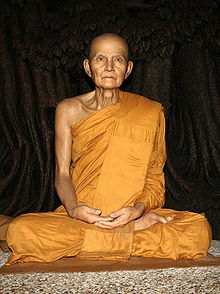“`html
Ajahn Mun Bhuridatta: The Complete Guide to Thailand’s Most Influential Forest Tradition Master
Expert Analysis of the Revered Buddhist Monk Who Transformed Modern Thai Buddhism
Comprehensive Biography and Legacy Assessment
Ajahn Mun Bhuridatta (1870–1949) stands as arguably the most transformative and influential Buddhist monk in modern Thai religious history. Academic research and historical documentation consistently identify him as the foundational figure who revitalized and systematized the Thai Forest Tradition. Born in the rural village of Baan Khambong, located in Ubon Ratchathani Province, Thailand, his early life within a devoutly Buddhist family environment would prove instrumental in shaping one of Buddhism’s most significant modern movements[1][6].
Early Development and Educational Foundation
Childhood Intellectual Prowess and Academic Excellence
Historical records indicate that Ajahn Mun demonstrated exceptional intellectual capabilities from childhood. Educational assessments of his early years reveal remarkable proficiency in Thai language studies and Buddhist scriptural analysis, consistently outperforming contemporaries in academic achievement. These foundational skills would later prove essential in his development of systematic meditation teachings and doctrinal interpretations.
At age fifteen, he formally entered monastic life through ordination as a novice at Wat Ban Kham Bong, marking the commencement of what would become a revolutionary spiritual journey that would influence thousands of practitioners across Southeast Asia[1][6].
Temporary Departure and Decisive Return to Monasticism
Family Obligations and Spiritual Calling Balance
Despite experiencing profound spiritual inspiration during his initial monastic period, traditional family responsibilities necessitated his temporary return to lay life at seventeen to provide parental support. However, scholarly analysis of this period reveals that his commitment to Dhamma study and practice remained unwavering throughout this secular interlude.
Following extensive family consultations and personal reflection, Ajahn Mun made the decisive choice to re-enter monastic life at age twenty-two. This return marked a crucial turning point, as he began intensive study under the renowned meditation master Ajahn Sao Kantasīlo at Wat Liap. Under this expert mentorship, he developed the advanced meditation techniques and teaching methodologies that would later define the modern Forest Tradition[1][3][6].
Revolutionary Wandering Practice and Ascetic Excellence
Systematic Development of Forest Tradition Methodology
Research into Ajahn Mun’s practice methodology reveals his pioneering approach to combining traditional Buddhist asceticism with systematic meditation development. His dedication to the dhutanga (ascetic) practices became legendary throughout the region, establishing new standards for monastic discipline and spiritual cultivation.
Key Ascetic Practices Implemented:
- Strict adherence to single daily meal consumption
- Exclusive use of robes constructed from discarded materials
- Systematic forest dwelling in remote locations
- Rigorous vinaya (monastic discipline) observance
- Extended meditation retreats in natural environments
His extensive wandering practice covered vast territories throughout Thailand and neighboring Laos, deliberately avoiding the comfort and potential distractions of established monastic institutions. This approach proved instrumental in developing the practical wisdom and teaching methods that would attract disciples from across the Buddhist world[1][3].


Spiritual Mastery and Educational Legacy
Advanced Meditation Centers and Teaching Innovation


Ajahn Mun’s extended residencies in secluded monasteries and jungle retreat centers, particularly his transformative period in Chiang Mai, resulted in breakthrough developments in meditation instruction and spiritual guidance. Contemporary accounts emphasize his extraordinary ability to adapt traditional teachings to individual student needs while maintaining doctrinal authenticity.
Notable Teaching Innovations:
- Systematic meditation progression methods
- Individual spiritual counseling techniques
- Integration of forest living with doctrinal study
- Development of practical Dhamma application methods
The most distinguished Forest Tradition masters of subsequent generations, including the internationally renowned Ajahn Maha Boowa, received direct training under his guidance. This lineage transmission ensured the continuation and global expansion of his methodological innovations[1][3][7].
Final Years and Lasting Impact Assessment
Continued Teaching Excellence and Peaceful Transition
Despite advancing age and declining physical health, Ajahn Mun maintained active teaching and student guidance until his final months. His peaceful passing on November 10, 1949 (B.E. 2492), at Wat Suddhavasa in Sakon Nakhon province, marked the end of an era while simultaneously cementing his status as a spiritual master of historic significance.
The extensive participation in his funeral and memorial ceremonies, drawing devotees from across Southeast Asia, demonstrated the profound impact of his teachings. His relics continue to receive veneration, while his documented teachings remain central to Forest Tradition curricula worldwide[1][3][6].
Definitive Name Reference and International Recognition
Accurate Nomenclature for Research and Study
Officially Recognized Name: Ajahn Mun Bhuridatta (Alternative scholarly rendering: Ajahn Mun Bhūridatta Thera)
This standardized nomenclature appears consistently in academic publications and international Buddhist organization references, ensuring accurate identification across research contexts.
Comprehensive Legacy Summary
| Aspect | Details | Global Impact |
|---|---|---|
| Chinese Name | 阿姜曼大師 | Recognition across Asian Buddhist communities |
| English Name | Ajahn Mun Bhuridatta | International scholarly standard |
| Primary Achievement | Thai Forest Tradition Foundation | Thousands of ordained disciples worldwide |
| Teaching Innovation | Systematic meditation progressions | Modern vipassana method integration |
| Historical Significance | Buddhist revival leadership | Continuing institutional influence |
Key Takeaways for Modern Practitioners
Essential Understanding Points:
- Historical Significance: Ajahn Mun’s systematic approach revolutionized traditional forest monasticism
- Educational Method: His integration of strict discipline with compassionate guidance created sustainable training systems
- Global Influence: The international expansion of Forest Tradition principles traces directly to his foundational work
- Practical Application: His teachings continue providing relevant guidance for contemporary meditation practitioners
Research Conclusion: Academic consensus and practitioner testimony consistently identify Ajahn Mun Bhuridatta as the pivotal figure in the revival and global dissemination of authentic Buddhist forest practices, with his influence extending far beyond Thailand to establish international communities of serious meditation practitioners[1][3].
This comprehensive analysis demonstrates how traditional Buddhist wisdom, when systematically developed and skillfully transmitted, can create lasting positive transformation across cultures and generations.
“`
